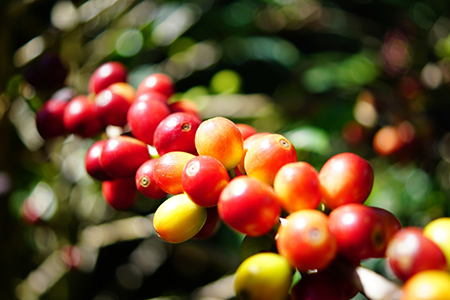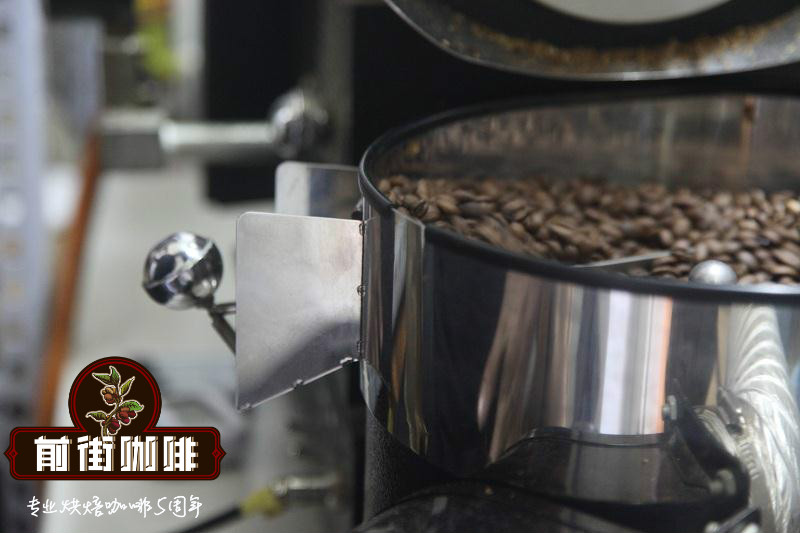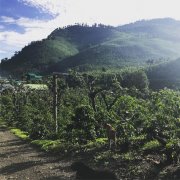Introduction of siphon brewing method for washing treatment of Costa Rican coffee Tarazhu Diamond Villa Garden
For professional baristas, please follow the coffee workshop (Wechat official account cafe_style)

Siphon pot (Syphon), commonly known as "plug wind pot" or "siphon", is a simple and easy-to-use method of coffee brewing, and it is also one of the most popular coffee brewing methods in cafes. Although the siphon kettle has the nickname of "plug wind type", it has nothing to do with the siphon principle, but uses water heating to produce water vapor, causing thermal expansion and cold contraction, pushing the hot water from the lower sphere to the upper pot, and then sucking back the water from the upper pot after the lower pot cools. Does that sound mysterious? Not at all. Follow the following steps and you will understand!
First, fill the water-hook the filter element
Fill the pot with hot water and mark it with the "two cups" icon. Put the filter element into the pot, hold the end of the chain with your hand, and gently hook it to the end of the glass tube. Be careful not to release the hook suddenly, so as not to damage the glass tube of the upper pot.
Second, ignite-insert the pot diagonally-waiting for big bubbles
Light the alcohol lamp and insert the upper pot obliquely so that the rubber edge is pressed against the spout of the next pot (rest assured that the upper pot will not fall off) so that the chain is soaked in the water. Then boil the water and wait for the pot to produce continuous bubbles. Just put the upper pot diagonally, don't let it clog the next pot, small bubbles don't count, wait for big bubbles to appear.
Third, upright-insert it into the upper pot
When large bubbles appear continuously in the lower pot, straighten the upper pot, shake it left and right and press it down slightly so that it is gently stuffed into the lower pot. After the upper pot is plugged in, you can see that the water in the next pot begins to climb up. If you have a bean grinder, you can start grinding beans now! Two cups of water use a medium grinding scale of three spoonfuls of coffee (about 24g)
Fourth, let the water in the lower pot rise completely to the upper pot.
After the water has completely risen to the pot, don't worry, wait a few seconds, and then prepare to pour in the coffee powder after the bubbles in the pot decrease a little.
Fifth, pour in the coffee powder-stir (left and right)
Pour in the ground coffee powder and move it around with a bamboo spoon to evenly remove the coffee powder into the water. The timing starts at the same time as the first stirring.
Stir gently to avoid violent stirring. If it is fresh coffee powder, it will float on the surface to form a layer of powder. At this time, the coffee powder needs to be stirred so that the flavor of the coffee can be completely extracted. The correct stirring action is to move the bamboo spoon in the left and right direction, with a "strong way" of downward pressure, to "press" the coffee powder floating on the surface of the water below the surface.
6. Stir twice more.-flameout
After the first stirring, time 30 seconds, make the second stirring, and then time 20 seconds for the final stirring-- the alcohol lamp can be removed. Take the pre-prepared (wrung-dry) slightly wet dishcloth and gently wrap the side of the lower pot from the side to prevent the wet cloth from touching the place where the alcohol flame at the bottom of the pot comes into contact, so as to prevent the pot from breaking. At this time, you can see that the water in the upper pot is quickly "pulled" to the lower pot. If your coffee is fresh enough, there will be a lot of light brown foam in the pot.
VII. Completion
After the coffee is sucked into the lower pot, hold the upper pot in one hand and the handle of the lower pot in the other, gently shake the upper pot to the left and right to pull out the upper pot and the lower pot. Pour the coffee into a warm coffee cup and enjoy the mellow coffee that you have prepared by hand.
Costa Rican coffee has always been regarded as the perfect classic taste, balanced, dry, sweet and is his base. This batch of Finca Montanas del Diamante comes from the famous Tarrazu fine bean region, which is famous for its excellent natural geographical conditions and excellent regional planting management technology. it has an almost perfect classic flavor and has a lively citrus flavor in the sense. The aromas of black grapes, melons and melons are smooth on the palate, with drupe / micro-flower aromas, while hints have intense coffee flower aromas. Its taste is clear, balanced, complex and changeable, soft orange, toast, dry taste, sweet caramel, sweet melon and good tail.
Costa Rica Finca Montanas del Diamante
Country: Costa Rica
Grade: SHB
Producing area: Tarazhu
Producer: Tarazhu local small farmers
Treatment: washing
Variety: Kaddura, Kaduai
Manor: Diamond Hill Manor
Flavor: soft orange notes, toast, caramel cocoa sweet
The taste is clean
Important Notice :
前街咖啡 FrontStreet Coffee has moved to new addredd:
FrontStreet Coffee Address: 315,Donghua East Road,GuangZhou
Tel:020 38364473
- Prev

Flavor characteristics of Ugandan coffee the difference between Ugandan Bugishu AA coffee and Kenyan coffee
For the exchange of professional baristas, please pay attention to the coffee workshop (Wechat official account cafe_style) East African Great Graben (that is, Rift Valley) connecting Weidoria Lake and Elgon Mountain is a famous and important boutique coffee belt in East Africa. The eastern side of Mount Elgon is one of the important coffee producing areas in Kenya, while the western side of Mount Elgon, the western highland on the Ugandan side, also produces great coffee.
- Next

Uganda AA- Bugisu coffee beans Ugandan coffee characteristics how about Ugandan coffee
Professional baristas Please follow the Coffee Workshop (Wechat official account cafe_style) Uganda is the second largest coffee producer in Africa, but it is made up of 90% robasta beans and only 10% Arabica beans. Coupled with the political unrest in recent years, the supply of goods is not very stable. If you like, try to enjoy when you can! The smell of coffee after grinding shows that ─ smells for the first time, fragrant but not sweet, with
Related
- Detailed explanation of Jadeite planting Land in Panamanian Jadeite Manor introduction to the grading system of Jadeite competitive bidding, Red bid, Green bid and Rose Summer
- Story of Coffee planting in Brenka region of Costa Rica Stonehenge Manor anaerobic heavy honey treatment of flavor mouth
- What's on the barrel of Blue Mountain Coffee beans?
- Can American coffee also pull flowers? How to use hot American style to pull out a good-looking pattern?
- Can you make a cold extract with coffee beans? What is the right proportion for cold-extracted coffee formula?
- Indonesian PWN Gold Mandrine Coffee Origin Features Flavor How to Chong? Mandolin coffee is American.
- A brief introduction to the flavor characteristics of Brazilian yellow bourbon coffee beans
- What is the effect of different water quality on the flavor of cold-extracted coffee? What kind of water is best for brewing coffee?
- Why do you think of Rose Summer whenever you mention Panamanian coffee?
- Introduction to the characteristics of authentic blue mountain coffee bean producing areas? What is the CIB Coffee Authority in Jamaica?

